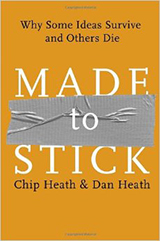My notes on “Made to Stick” by Chip & Dan Heath
S.U.C.C.E.S.s: Simple, Unexpected, Concrete, Credible Stories
Simplicity
- Not dumbed down or sound bites
- Find the core fo the idea
- “The curse of knowledge” if you say 3 things you say nothing
- Simple = core + compact, forced prioritisation
- To make a profund idea compact use flags – “tap the existing terrain of your audience”
- Schema’s are a collection of generic properties of a concept or category
- Higher level schemas are composed of other schemas. Analogies are great
- The goal is to write a proverb
Unexpected
- Mostly we can’t demand attention, we must attract it. How? Break pattern
- 2 essential emotions: Surprise & Interest
- Makes us want to understand why our schema failed, we pay attention
- But it must reinforce your core message or it’s useless. Produce insight
- Fix the audiences guessing machine
- Eg Nordstrums policy isn’t just “the best customer service” they tell stories to staff about refunding snow tires when they don’t even sell them!
- An “aha!” experience sis much more satisfying when preceded with a “huh?”
- A schema change takes a moment “bang!”, a mystery is a journey
- Curiosity is when we feel a gap in our knowledge. It’s painful
- This gap is more painful than walking away from a bad movie
- Story’s pose questions & open situations. That’s how news headlines previews are written
Concrete
- Be concrete, not abstract
- Give examples, use analogies
- Memory is like velcro
- A credit card has one hook, your childhood home has gazillions
- Memory is not a filing cabinet
Credibility
- Details enhance credibility. Vivid details
- Statistics are rarely meaningful or memorable
- They should be used to illustrate relationships
- Help people remember the relationship Eg BB gun bullets in a bucket represent the worlds nuclear warheads
- Only with scale & context do they make sense
- External credibility: authorities and anti-authorities
- Internal credibility: statistics, examples
Emotional
- Analytical thinking hinders emotions Eg providing statistics when giving to Rwanda. Eg2 “think, don’t smoke”
- Putting “you” in headlines is good, asking the reader to visualise themselves using the product or sponsorign the child is better
- Self interest appeals work, but so do group interest appeals, and identity appeals
- Who do they think they are? Who do they want to be?
- Eg: “don’t mess with Texas”
Stories
- Stories provide simulation (knowledge about how to act) and inspiration (motivation to act)
- Visualising success doesn’t work as well as visualising the event
- Visualising can produce 2/3rds of the benefits of actual physical exercise
- Visualising ourselves in a vivid story is the next best thing to being there
- Most common plots:
- Challenge plot (Eg David v Goliath, Jared from Subway)
- Connection plot (Eg a relationship that bridges a gap in race, class, ethnicity Eg Romeo & Juliet, Titanic
- Creativity plot (longstanding puzzle, mental breakthrough, innovation Eg MacGyver)
